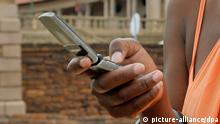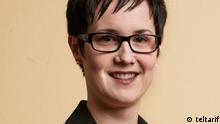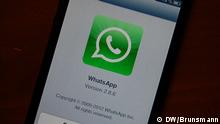First, we need to construct our RF (radio frequency) grounding. Without this grounding, the current can't flow through the primary winding of the transformer. Once the grounding is finished and we have made the transformer, we can do the first tests of our system.
The grounding is a 2,5 meter (8 feet) long copper water tube, at least 20 mm (0.8 inch) in diameter, found in your local DIY store (use blank copper tubes!). If you have the materials and the money, you may use a longer tube with a larger diameter. Select a location where rain can easily penetrate the ground. Try avoiding areas with concrete or large plants or trees, as those absorb a major part of the water and you'll be left with dry soil that doesn't conduct enough for our antenna system. You could make the surface descending a bit towards the grounding to guide rainwater towards it.
The tube is driven 2,5 meter deep in the soil. Don't try hitting the tube in the ground with a hammer (and bending it eventually). There's a far easier way to do this with the help of hydro-power! Simply take a piece of plastic tube with one end attached (witch a standard connector) to your garden hose, and the other end pushed over the copper tube and tightened with a clamping ring. Open the water tap and push the water spraying end of the copper tube in the ground. With the help of the water, the tube will go downwards with very little force. Oh, and wear boots or slippers, it gets pretty wet around you!
I managed to drive my copper tubes the full 2,5 meters into the ground within a mere 2 minutes! I encountered a clay layer but with some poking, it got through without any problem. You'll be amazed how fast this goes! Use grounding wire (flat woven copper car battery cable) or several twisted thick copper wires to connect the copper tubes to the antenna system. Connect the ground wire with a special electrical grounding clamp to the copper tube or twist it several turns around the tube and solder it with a big soldering iron or gas burner firmly to the tube. Seal off the connection with adhesive and/or heat-shrink to make the connection weather resistant.
IMPORTANT SECURITY NOTE: NEVER use the AC ground, found on the 220V outlets at home as RF grounding. Apart from being stupidly dangerous, the electric installation's grounding is the worst ever RF grounding. If you don't have a garden or suitable soil to drive the copper tubes into, you might consider burying copper wire radials horizontally in the top soil or laying them on the surface. These copper wires should run underneath the antenna wire and act as a virtual earth. Check the Internet for more info on RF radials.
The Transformer
The primary function of the 9:1 transformer (this type is also called Unun or unbalanced to unbalanced) is to bring down the very high impedance, typical for end-fed longwire antennas, to a lower impedance that is suitable for most receivers. An interesting property of this type of transformer is that the primary winding is directly connected to the ground, preventing the buildup of static on the antenna.You could buy these Unun transformer but these quickly cost more than 30 Euros or $35 and most of them - sadly - don't have a separate ground connection. For receiving purposes only, you can make them yourself for less than 5 euro. The most expensive part will probably be its housing. I used a professional box, but you can just as well use a pillbox or a short piece of PVC water tube with two stops. Just make sure that the container is waterproof. There are plenty of DIY Unun construction ideas on the Internet.
Making you own transformer sounds scarier than it actually is. First, you need to find a suitable toroid ferrite core. For receiving purposes only, the core material, size and windings are far less critical. You can find such toroid cores (suitable to make HF transformers) in good electronic shops or on the Internet. If you really, really, can't get hold of a toroid ferrite core, you could recover the ferrite rod from an old portable radio. This will also work pretty well as transformer, but you'll have to experiment a bit with the windings. However, toroids are better transformers and they are immune to external electromagnetic interference because of their circular shape.
Here in Europe, Conrad sells the 26 mm toroid core part # 500671 for a few Euros. In contrast to the image on their website, they are well coated (in blue) and of good quality. I used exactly these and, as you can see in my SWL log below, they do an excellent job! You can use 0.5 or 1.0 mm enameled copper wire (the latter stays better in place but it gets a bit tight inside the core). Never use blank copper wire because without isolation you'll shortcircuit the windings! Before starting to wind, measure the circumference of one turn around the core and multiply that by 24. Add some 20 cm (8 inch) extra to connect the transformer.

We need 24 turns for the primary (large) winding, divided over three times 8 windings. Start winding the wire tight around the core and divide the 8 turns over the whole circumference of the core (see A). Bend the wire well around the corners to keep the wire against the core. Pass the starting point of the wire and continue to wind with the long piece of wire a second series of 8 turns, just next to the previous turns and finally wind a third series of 8 turns, again next to the previous windings (the result should look like B). The secondary (small) winding has only 8 turns. You start at the opposite side of the core and wind the 8 turns nicely next to the existing windings around the circumference of the whole core (see C) until you arrive back at the opposite side.
Note that some people wind such quadfilar toroids with four separate wires at once and then solder the separate parts of the wirings together. For such small toroids, I find it easier and faster to use a single wire for each winding. A good advice: start with a wire that is long enough!
Finished? Congratulations, you just made a quadfilar 9:1 transformer! Not that hard. Make sure to mark the primary and secondary windings so that you don't mix up the connections! Now that your first donut received its stripes, and before you put it in its housing, you might already want to do some quick testing. Solder one wire of the primary (larger) winding, one of the secondary (smaller) winding, and two test wires all together (scrape off the enamel before soldering). One of the test wires goes to the ground and one is soldered to the sleeve of a 3,5 mm stereo jack. The free wire of the primary winding goes to the antenna and the free wire of the secondary winding is soldered to the tip of a 3,5 mm stereo jack.
String up the long wire, put the jack into the receiver's external antenna socket and start testing all HF bands. Normally, 24 and 8 turns on the toroid should tune the whole band pretty well. If really necessary, adjust the number of turns (in that case, you'll need to rewind the toroid completely) with a few more windings to emphasize lower frequencies or a few less windings for higher frequencies. Do keep the same 3 to 1 radio (this provides the 9:1 transformation).
Finally, if you're happy with the result, unsolder the wires and put the toroid core in a watertight box. Solder the toroid wires to the connectors (solder grease makes the job easier): solder one side of the primary winding, one side of the secondary winding and the ground (chassis) of a BNC connector all together to the grounding bolt. The remaining wire of the primary winding goes to the antenna bolt, and the remaining wire of the secondary winding is soldered to the bus connection of the BNC connector.
Antenna Construction
| The antenna is
21,5 meters (70.5 feet) of thin copper wire (a
steel wire can also be used but copper has better
electrical properties). This can be normal
electrical copper wire (1 or 2 mm) or copperweld
antenna wire (which is stronger than normal
copper wire and doesn't stretch as much). You can
use insulated wire, which also protects the wire
against the sun and pollution. Its length is
ideal for the 20 meters ham DX band (14.2 MHz)
and a compromise that enables good reception on
the lower and higher shortwave frequencies. If
you use black insulated wire, you will have a
very stealthy antenna. Such wires are virtually
invisible. Antenna masts or trees that blend in
the landscape are a plus (my wife loves gardens
and dislikes antennas, but she never
complained...so far).The
antenna is attached to two insulators which are
attached to nylon tension cords (3 to 4 mm). On
one side of the antenna, the cord runs through a
pulley downwards where a weight keeps the antenna
wire straight (dangling copper wires eventually
break). Select a weight that only prevents the
wire from moving too much but doesn't stretches
the wire until breaking point. On the other side,
the cord is attached directly to the mast and the
insulated antenna wire travels vertically down
the mast to the 9:1 transformer. Never place the transformer at the top of the mast (like many do with a 9:1 balun for end-fed antennas), since you need a good - short - grounding. If you'd place it on top of the mast, the long grounding wire will capture additional interference since it acts as a second pole for the antenna. Also, don't try replacing the vertical part of the wire with a coax of which the shielding is grounded, in some kind of attempt to move the active part of the wire to the top of the mast. It "looks" like a good idea but unfortunately, the low impedance coax will act like a short-circuit to the very high impedance of the wire antenna and seriously attenuate the signal. |
|
You can buy insulators or homebuilt them yourself. The common white plastic 5 mm thick cutting boards, used in the kitchen, are great for this purpose. You can make insulators, like the one on the photo above, by sawing (or with a drill with circular cutting blade) two rounds, about 30 mm diameter, and two rounded rectangles. Next, you drill holes into the little rounds and the rectangles, place the rounds between the rectangles and fix them together with two bolts. I also drilled two little holes at the side of the insulator to attach straps that support the wire that goes down.












 Sebagaimana
tahun-tahun sebelumnya, China Radio International seluruh seksi bahasa
Asia Tenggara menyelenggarakan pemilihan berita populer sepanjang tahun.
Tahun ini CRI kembali mengajak pendengar dan pengguna internet
bersama-sama meninjau ulang seluruh tahun 2012 dan ambil bagian dalam
pemilihan “10 Berita Utama Asia Tenggara 2012″. Dalam menggelar acara
ini, CRI bekerjasama dengan partner dari kawasan ini, seperti Harian
Qiandao Ribao, Radio
Sebagaimana
tahun-tahun sebelumnya, China Radio International seluruh seksi bahasa
Asia Tenggara menyelenggarakan pemilihan berita populer sepanjang tahun.
Tahun ini CRI kembali mengajak pendengar dan pengguna internet
bersama-sama meninjau ulang seluruh tahun 2012 dan ambil bagian dalam
pemilihan “10 Berita Utama Asia Tenggara 2012″. Dalam menggelar acara
ini, CRI bekerjasama dengan partner dari kawasan ini, seperti Harian
Qiandao Ribao, Radio